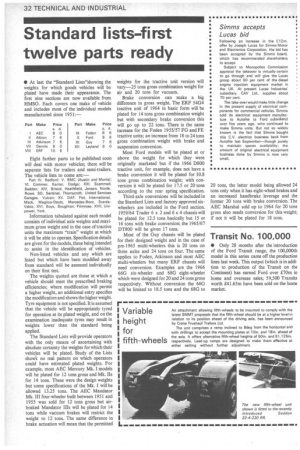Standard lists-first twelve parts ready
Page 34

If you've noticed an error in this article please click here to report it so we can fix it.
• At last the "Standard Lists"showing the weights for which goods vehicles will be plated have made their appearance. The first nine sections are now available from HMSO. Each covers one make of vehicle and includes most of the individual models manufactured since 1951:— Eight further parts to be published soon will deal with motor vehicles; there will be separate lists for trailers and semi-trailers.
The vehicle lists to come are:— Part IV, Bedford; V. BMC (Austin and Morris); VI, Commer, Kerner, Dodge; XIII, Scammell, Seddon; XIV, Bristol, Heathfield, Jensen, Norde, Rowe, SD, Sentinel. Thornycroft, United Services Garages. Vulcan; XV, DAF, Fiat, International, Mack, Magirus-Deutz, Mercedes-Benz, ScaniaVabis: XVI, Boys, Boughton, Primrose; XVII, Unipower, York.
Information tabulated against each model consists of individual axle weights and maximum gross weight and in the case of tractive units the maximum "train" weight at which it will be able to operate. Specification details are given for the models, these being intended to assist in the identification of vehicles.
Non-listed vehicles and any which are listed but which have been modified away from standard will be assessed individually on their first test.
The weights quoted are those at which a vehicle should meet the prescribed braking efficiencies; where modification will permit a higher weight, an additional entry specifies the modification and shows the higher weight. Tyre equipment is not specified. It is assumed that the vehicle will be appropriately tyred for operation at its plated weight, and on the examination inadequate tyres may result in weights lower than the standard being applied.
The Standard Lists will provide operators with the only means of ascertaining with absolute certainty the weights for which their vehicles will be plated. Study of the Lists shoWs no real pattern on which operators could have estimated plated weights. For example, most AEC Mercury Mk. I models will be plated for 12 tons gross and Mk. Hs for 14 tons. These were the design weights but some specifications of the Mk. I will be allowed 13.25 tons. The AEC Mandator Mk. III four-wheeler built between 1951 and 1955 was sold for 12 tons gross but airbraked Mandator Ills will be plated for 14 tons while vacuum brakes will restrict the weight to 12 tons. The same difference in brake actuation will mean that the permitted weights for the tractive unit version will vary-25 tons gross combination weight for air and 20 tons for vacuum.
Brake conversion can make a big difference in gross weight. The ERF 54G4 tractive unit of 1964 in basic form will be plated for 14 tons gross combination weight but with secondary brake conversion this will go up to 22 tons. There is the same increase for the Foden 1955/57 FG and FE tractive units; an increase from 18 to 24 tons gross combination weight with brake and suspension conversion.
Most Ford models will be plated at or above the weight for which they were originally marketed but if the 1966 D800 tractive unit, for example, does not have a brake conversion it will be plated for 10.8 tons gross combination weight; with conversion it will be plated for 17.5 or 20 tons according to the rear spring specification.
Third-axle conversions will be included in the Standard Lists and factory approved sixwheelers are included in the Ford section. 1959/64 Trader 6 x 2 and 6 x 4 chassis will be plated for 12.5 tons basically but 15 or 16 tons with brake conversion; the 1965/67 DT800 will be given 17 tons.
Most of the Guy chassis will be plated for their designed weight and in the case of pre-1965 multi-wheelers this is 20 tons on three axles and 24 tons on four. The same applies to Foden, Atkinson and most AEC multi-wheelers but many ERF chassis will need conversion. Examples are the 1966 660 six-wheeler and 68G eight-wheeler which were designed for 20 and 24 tons gross respectively. Without conversion the 660 will be limited to 18.5 tons and the 68G to 20 tons, the latter model being allowed 24 tons only when it has eight-wheel brakes and an increased handbrake leverage and the former 20 tons with brake conversion. The AEC Marshal sold up to 1964 for 20 tons gross also needs conversion for this weight; if not it will be plated for 18 tons.










































































































